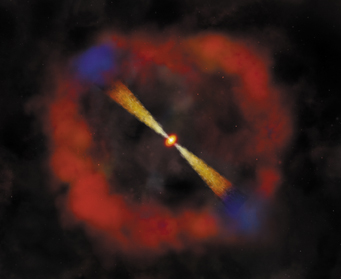Burst busters
A powerful type of explosion in outer space is much more common, but not always as powerful, as astronomers had thought.
By Emily Sohn
Explosions on Earth are a pretty big deal. In outer space, though, things are blowing up all the time. Two new studies show that a particularly powerful type of explosion is 10 times as common, but not always as powerful, as astronomers had thought.
The explosions are called gamma-ray bursts. One seems to appear whenever a dying star collapses and becomes a spinning black hole or neutron star. Particles burst out of a doughnut-shaped disk that surrounds the collapsed star, producing gamma rays.
 |
|
In this model of a gamma-ray burst, jets of high-energy particles emerge from a rapidly rotating black hole (center) and then slam into surrounding matter.
|
| M. Weiss/CXC |
A leading theory proposes that all gamma-ray bursts have the same amount of energy. In that case, the energy we detect here on Earth mostly depends on how far away the explosion is and how much of the blast is aimed in our direction.
New data cast doubt on that assumption. On Dec. 3, 2003, a European satellite called INTEGRAL recorded an unusual gamma-ray burst officially labeled GRB 031203. Two teams, one from Russia and one from California, looked closely at the data.
They found that the burst happened in a galaxy that is relatively close to us, just 1.3 billion light-years away. Oddly, though, it had only about one-thousandth as much energy as do bursts that come from much farther away. Analysis of the afterglow confirmed that the burst was a low-energy event.
Astronomers might be missing many gamma-ray bursts because they’ve been looking only for high-energy explosions, the researchers say. In October, the scheduled launch of a satellite called Swift might help resolve the issue. Swift is designed to register fainter bursts than telescopes on Earth normally detect.







